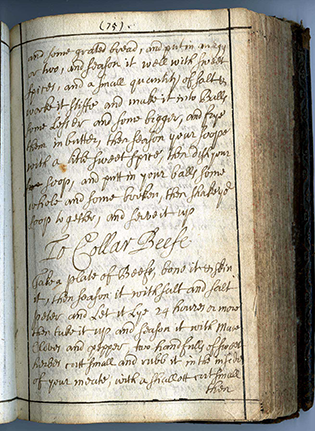A birthday party for Jonathan Swift
Published in Issue 6 (November/December 2017), News, Volume 25This year marks the 350th anniversary of the birth of Jonathan Swift, and the festival being held by, in and around St Patrick’s Cathedral is one of various events that focus on the great man.

Above: How ‘To make a Peas soope’ and ‘To Collar Beefe’, from ‘A Book of Cookery for dressing of severall dishes of Meate and making of severall sauces and seasoning for Meat or Foule’ by Hannah Alexander.
On 26 November St Patrick’s Cathedral is holding a dinner in celebration of Swift with a special twist: the meal is being prepared from a recipe book written in the late seventeenth/early eighteenth century on Dublin’s Ship Street—just around the corner from the cathedral—by a Hannah Alexander. Hannah and her family were known to Swift, so he may well have eaten at their table.
Hannah was the socially ambitious young second wife of a Dublin Castle employee. While almost nothing is known about her personal life, she left a legacy in the form of a handwritten recipe book over 40,000 words long, including recipes for sweet and savoury dishes, soft and alcoholic drinks, and herbal and other ‘cures’ for a variety of ailments. In Hannah’s time Dublin was a bustling port, and cooks could access not just Irish ingredients but also a wide array of flavours from the expanding British Empire and beyond. Among the more exotic ingredients featured in Hannah’s recipes are ambergris (a form of solidified mucus ‘coughed up’ by sperm whales that is found washed up on beaches and still used today in perfumery) and musk. Ingredients that subsequently passed out of fashion in Ireland, only to be rediscovered in more recent years, include anchovies, saffron, olives and a variety of spices from the Indian subcontinent. Copious amounts of alcohol are involved in many recipes—and in many of her ‘cures’. In particular, women’s ailments seem to have been greatly ameliorated by brandy.
When Hannah died, she passed the book on to her daughter, also called Hannah, who added a few recipes of her own. In reduced circumstances, in her later years the younger Hannah retired to New Ross, Co. Wexford, bringing the book with her. It stayed in a drawer for nearly 300 years, and was finally published in 2014 after being transcribed, edited and researched by Deirdre and Jennifer Nuttall.
Today, Ireland’s chefs, and the Irish public, are rediscovering our rich culinary heritage and food history. It is important to remember that this is also a history of Irish women and that, throughout the vicissitudes of Irish history, Irish women of all social classes strove to provide meals for their families. It is entirely appropriate for the celebration of one of Ireland’s great social reformers that one of the events commemorating his achievements also marks those of the countless women who fed not just the great and good but everybody else as well.
Prepared by Mary Farrell, head chef at Morton’s, the menu on offer at the event sounds very intriguing; it includes eel, buttered and seasoned, pees [sic] porridge, saffron bread, fricassee of chicken, orange fool and Lady Owen’s sugar cakes.
Bookings can be made, and copies of the book purchased, here: https://jonathanswiftfestival.ie/event/swifts-food/
Read More:
‘To hash a calves head’
















